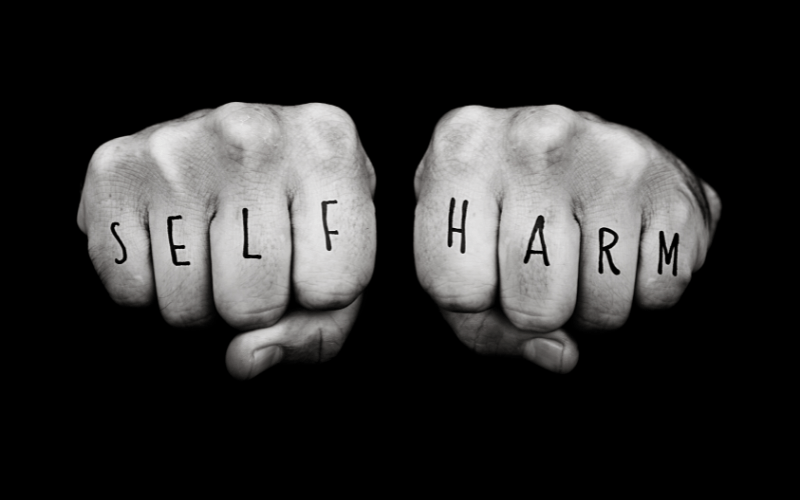EMDR Therapist Self Care
Guest Blog Post by Suzanne Rutti, MSW, LISW-S
Tell us a little about you, your experience becoming an EMDR therapist, and what drew you to the topic of secondary trauma and therapist self-care.

I first learned about EMDR therapy as an intern during my graduate program. I was working at a grant-funded program that served children who had been exposed to trauma, and while I was there the staff was trained in EMDR therapy. I immediately saw a shift in how the clinicians at the practice were able to support their clients. I was also fortunate to have an amazing clinical supervisor who helped me to shape my trauma-focused lens. I largely credit her with developing my ability to see individual clients’ symptoms and behaviors as reactions to trauma and stress. I advocated strongly to get trained in EMDR therapy during my first job working in a partial hospitalization program for youth. I, too, saw a quick shift in my clinical practice and ability to actually help my clients heal. At the same time, looking back, that job is also probably where I experienced some of the most secondary traumatic stress and burnout symptoms in my career. I wasn’t aware of all of that, necessarily, until those symptoms resurfaced in my next job and began impacting me not just emotionally but physically as well.
That second job in my career is where I spent about six years working directly with survivors of crime and trauma at another grant-funded program. The program was saturated with devastating stories of recent traumatic experiences that qualified individuals to receive our services. What we weren’t prepared for was working with all of the other experiences that these individuals had survived prior to that final event that brought them into treatment. We found ourselves working with very intense, complex cases on a longer-term basis than the program was originally designed for. Fortunately, the program was equipped with training resources where I continued developing my EMDR therapy career and became an EMDR Consultant. The program also offered integrated support for secondary traumatic stress, which is where I first learned about this as a concept. To clarify: not in my graduate program. But years into my career. Having a space to name our responses to the work we were doing started me on the path of not only doing my self-work but also raising awareness about the topic to other helping professionals. Having this awareness has also helped me to navigate shared traumatic experiences with clients, such as the pandemic and political stressors. Initially, the work started in my clinical sessions, working with professionals as clients, and has evolved into community training and support. I now make a conscious effort as an EMDR Therapy Trainer to talk about secondary traumatic stress in foundational trainings and throughout the consultation process. I hope clinicians understand that this is a real thing that we experience and that it is not a life sentence.
Can you briefly help us understand a little more about the terms secondary trauma, compassion fatigue, and/or burnout and how that might affect an EMDR therapist?
I find myself resonating with several approaches and theories regarding secondary traumatic stress, compassion satisfaction, and burnout. One of those is the work of Dr. Beth Hudnall Stamm (2010), author of the Professional Quality of Life Scale (ProQOL). While the ProQOL itself has some limitations (Geoffrion, et. al, 2019; Heritage, et. al., 2018), the terms themselves are helpful in conceptualizing what we may be experiencing as helping professionals. She distinguishes two different aspects of professional quality of life: compassion satisfaction and compassion fatigue. Compassion satisfaction includes the benefits of doing the work that we are doing and is what tends to keep us in the field. Compassion fatigue is the negative side effect of this work, and she divides these into two separate concepts: burnout and secondary traumatic stress. Burnout tends to be what is talked about more in our profession: the physical exhaustion, high caseloads, feelings of hopelessness and powerlessness, and general crispiness we tend to get when we have worked in fields that have high demands physically and emotionally. Secondary traumatic stress, though, is different. These are the symptoms that mirror those of our clients based on the stories we witness. Things like hypervigilance, fear, anxiety, dissociation, and insomnia. This article focuses on secondary traumatic stress, but it is important to acknowledge that secondary traumatic stress, burnout, and compassion fatigue all intersect and it is hard to talk about one without the others.
Are there any myths you’d like to bust about secondary trauma for EMDR therapists?
A common myth is that these conditions are inevitable and that there isn’t really anything we can do about it. They are just part of the job. This myth contributes to systemic problems, oppression, and structural violence that cause harm to employees. It leads to continued unreasonable expectations and work demands and underpaid employees. The job-demands resources theory (JD-R) (Bakker & Demerouti, 2006) examines the implications of the imbalance of available resources versus the demands of the job. Research has shown a higher risk of burnout and secondary traumatic stress symptoms when helping professionals do not have access to social support, experience ethical conflicts such as moral injury, and are under-compensated (Lev et al, 2022).
How can an EMDR therapist work to mitigate secondary trauma? What successes have you seen?
When considering what we should do about secondary traumatic stress, a lot of my work is based on the compassion fatigue resilience model (CFR) (Ludick & Figley, 2017). What I appreciate about the model is that it identifies potential contributors and protective factors to the development of secondary traumatic stress. Risks include things like empathy, past traumatic experiences, and other life demands, while protective factors include access to social support, self-care, and compassion satisfaction. Using this model, I have been able to support both myself as well as clients and peers in identifying personal protective and risk factors before developing a plan of action. Working with secondary traumatic stress is not a one-size-fits-all model. We are not just impacted by our clients’ stories in a vacuum. We are each individual human beings who have individual personalities, histories, and tendencies, and it is essential that we explore these factors when working on a plan. Action plans can include increasing self-care and work-life balance, but that isn’t enough when it comes to the work many of us are doing. That also may be what has kept us from continuing to explore an action plan, because previous plans have not been enough. Action planning for managing and preventing secondary traumatic stress needs to be multi-tiered, meaning there needs to be an individual focus on the personal impacts of exposure to the traumatic material, but also systemic and administrative changes to support and minimize the impact of trauma exposure (Sprang et. al, 2019). Including both tiers means self-work, psychotherapy (including EMDR therapy), social justice, advocacy, professional and clinical boundary setting, personal support, community engagement, professional development, training, consultation, and supervision. The successes that I have seen are when professionals as clients are able to integrate these strategies and skills into their own Phase 2 Preparation and are then able to work through secondary traumatic stress symptoms and targets during reprocessing. Thematic history taking in Phase 1 helps them to connect their current symptoms and negative cognitions that they are experiencing from exposure to their clients’ stories to their own personal histories, identities, and experiences. This also leads to an increased capacity for action steps in their agency or field, such as advocacy work.
What multicultural considerations might EMDR therapists need to keep in mind regarding secondary trauma?
Ludick & Figley’s (2016) CFR model highlights risk factors for developing secondary traumatic stress, but one factor that is largely missing is that of identity. It is essential to incorporate intersectionality when we are exploring risk factors. Chronic oppression and intergenerational trauma put individuals at an increased risk for the development of trauma and secondary traumatic stress symptoms (Shell, et. al, 2021). Systemic oppression is an additional layer that chronically oppressed individuals are working against while also managing the stress of clinical work. We cannot talk about burnout and secondary traumatic stress symptoms without also considering aspects of identity and oppression.
What complexities or difficulties might EMDR therapists encounter that might prevent them from implementing self-care plans?
The biggest barrier I have seen to EMDR therapists implementing their own self-care plans is time. We put ourselves last. We don’t make time for ourselves to do our own work. My best advice is to schedule your own self-work as part of your work day. Block it out. Don’t schedule over it. Prioritize it like you would a client session. Because the reality is, if we don’t take care of ourselves, we are not going to be able to continue to do this work. This is coming from a recovering workaholic who experienced enough burnout and secondary traumatic stress at a point in my career that made me realize that I either needed to make some changes or that I was no longer going to be serving my clients well. I haven’t realistically considered actually fully leaving the field, and I think that is also a problem when it comes to clinician wellness. We push through it. We work long hours when we physically and emotionally are not taking care of ourselves. We continue to work with clients when maybe we shouldn’t be. Remember your ethical code. We have a responsibility to our clients and part of that is taking care of ourselves so that we can show up for them in the best way possible and do no harm.
What is your favorite free resource that you would suggest to other EMDR therapists interested in learning more about implementing self-care strategies?
My current favorite resource I have been loving right now are the free therapeutic yoga classes for trauma that Arielle Schwartz is currently offering to the community. It has been extremely helpful for me to have a physical way to increase my vagal tone, increase somatic awareness, and access a state of rest. I access them here: https://drarielleschwartz.com/therapeutic-yoga-classes.
You have shared about EMDR therapist self-care, are there any other general self-care tips you might suggest to other readers?
Do your own EMDR therapy! Also, though, find opportunities for restorative work. Find your communities and spaces where you can exist and be you. Find opportunities to access and explore liberation. We live in a world where our worth is often defined by our work and what we are producing. I encourage you to explore what else “productive” can mean for you.
Suzi Rutti, MSW, LISW-S, is an EMDR therapist who works with clients of all ages. She provides EMDR therapy foundational and advanced training on a variety of topics including ethics, children, preverbal trauma, and secondary trauma. Rutti has a passion for supporting helping professionals, and believes in the importance of making high quality trauma treatment accessible to all communities.
References
Bakker, A. B., & Demerouti, E. (2007). The job demands-resources model: State of the art. Journal of Managerial Psychology, 22(3), 309-328. https://doi.org/10.1108/02683940710733115
Geoffrion, S., Lamothe, J., Morizot, J. & Giguère, C.C. (2019). Construct validity of the Professional Quality of Life (ProQOL) Scale in a sample of child protection workers. Journal of Traumatic Stress, 32(4), 566-576. Open access: https://doi.org/10.1002/jts.22410
Heritage, B., Rees, C.S., & Hegney, D.G. (2018). The ProQOL-21: A revised version of the Professional Quality of Life (ProQOL) scale based on Rasch analysis. PLOS One, 13(2). Open access: https://doi.org/10.1371/journal.pone.0193478
Lev, S., Zychlinski, E., & Kagan, M. (2022). Secondary traumatic stress among social workers: The contribution of resilience, social support, and exposure to violence and ethical conflicts. Journal of the Society for Social Work and Research, 31(1), 47-65. Open access: https://doi.org/10.1086/714015
Ludick, M. & Figley, C.R. (2017). Toward a mechanism for secondary trauma induction and reduction: Reimagining a theory of secondary traumatic stress. Traumatology, 23(1), 112-123. https://doi.org/10.1037/trm0000096
Shell, E. M., Teodorescu, D., & Williams, L. D. (2021). Investigating race-related stress, burnout, and secondary traumatic stress for black mental health therapists. Journal of Black Psychology, 47(8), 669-694. https://doi.org/10.1177/00957984211033963
Simmons, L. A., & Wright, O. (2023). Vicarious trauma, compassion fatigue and burnout: Tools for EMDR therapists. EMDR Therapy Quarterly. https://etq.emdrassociation.org.uk/2023/10/17/vicarious-trauma-compassion-fatigue-and-burnout-tools-for-emdr-therapists/
Sprang, G., Ford, J., Kerig, P., Bride, B. (2019). Defining secondary traumatic stress and developing targeted assessments and interventions: Lessons learned from research and leading experts. Traumatology, 25(2), 72-81. http://dx.doi.org/10.1037/trm0000180
Stamm, B.H. (2010). The concise ProQOL manual, 2nd ed. Pocatello, ID: ProQOL.org.
Back to Focal Point Blog Homepage
Additional Resources
If you are a therapist interested in the EMDR training:
- Learn more about EMDR therapy at the EMDRIA™ Library
- Learn more about EMDR Training
- Search for an EMDR Training Provider
- Check out our EMDR Training FAQ
If you are EMDR trained:
- Check out the EMDRIA™ Let’s Talk EMDR Podcast
- Check out the EMDRIA™ Focal Point Blog
- Learn more about EMDRIA™ membership
- Search for EMDR Continuing Education opportunities
If you are an EMDRIA™ Member:
Date
December 20, 2024
Contributor(s)
Suzanne Rutti
Practice & Methods
Self-Care





